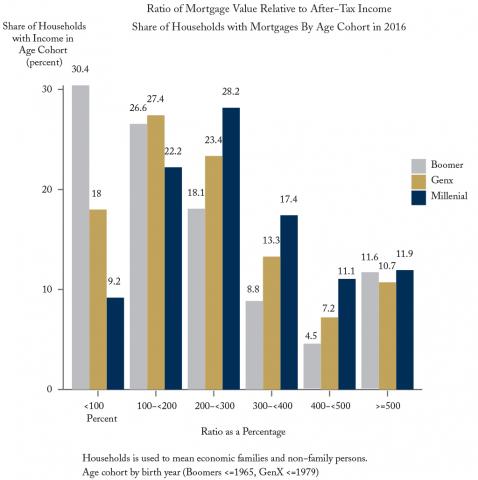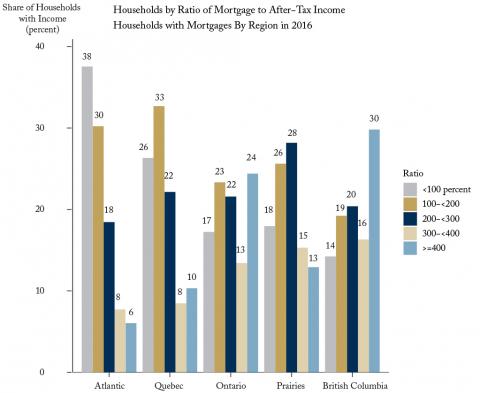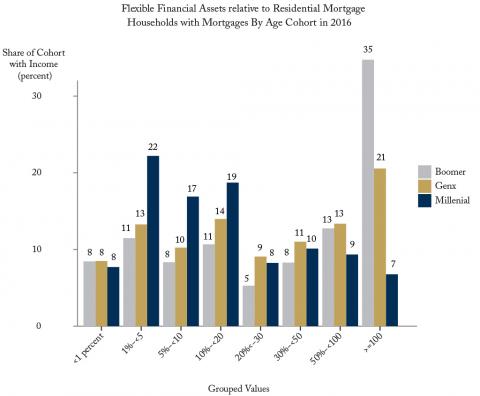From: Paul M. Jacobson
To: Canadians concerned about debt levels
Date: May 21, 2019
Re: Is There a Big Mortgage Debt Problem?
In our 2015 C.D. Howe Institute study, Craig Alexander and I looked at some aspects of household mortgages in Canada. The main research dataset was the 2012 cycle of the Survey of Financial Security (SFS).
This note provides some companion analysis based on the 2016 cycle, which contains 12,429 weighted observations on economic families and non-family persons. Broadly speaking, the conclusions are identical. Some households had taken on very substantial primary-residence mortgage debt. However, most households with mortgages have no real issues. And, not surprisingly, the greatest risks are in the regions with the highest housing prices.
The two charts below serve to highlight the general picture. Figure 1 shows the distribution of mortgage debt relative to income for three age groups: baby boomers (pre-1965), GenX (pre-1979) and millennials. As would be expected, most boomers with mortgages are not terribly constrained. However, it is notable that all three age groups have a similar share of households, roughly 11 to 12 percent, with mortgages five times larger than their income. This could indicate some real potential for stress if their economic circumstances change. Figure 2 presents the same data with a regional focus. Not surprisingly, given housing prices, the share of highly indebted households is largest in Ontario (24 percent) and B.C. (30 percent).
Figure 1:
Figure 2:
The asset side of the picture does not always receive enough emphasis. One advantage of the Survey of Financial Security is that it covers both assets and liabilities. The asset value of the home is always recognized but, as the primary residence, it is not easily used to meet financial obligations without sale. Similarly, the capitalized value of employer pensions is also a potential asset but cannot be used to offset financial difficulties very easily. However, many households still have significant flexible assets.
For the purposes of this note, these were defined to include deposits, RIFs, RRSPs and mutual funds. A significant share of each age cohort had more than $200,000 of flexible assets in 2016. Less than 20 percent of each cohort had under $5,000 as a cushion. On the other hand, the figure below shows that assets exceeded the value of the mortgage for many households.
Figure 3
The important policy point is that any potential debt issues are not widespread but are limited to a relatively small proportion of households with mortgages. Most mortgage-holders have a debt load below the concerning thresholds. Any tools to improve the situation should therefore be targeted, not broad-based. In a recent blog post (here), Cecchetti and Schoenholtz summarized the factors leading to a housing price collapse and concluded the best prevention tools were macroprudential ones, such as limiting debt-service-to-income and loan-to-value ratios.
Canada has a more consistent regulatory framework than the US for managing mortgage risks. A staff analytical note, released in November 2018 by the Bank of Canada (here), indicates that tightening of mortgage rules and the revisions to the stress test guidelines were having the desired effect of improving mortgage quality at the margin. Clearly such macroprudential tools are the important mechanisms for maintaining a good mortgage environment. Their apparent success suggests that such policies should be continued. Modifications, if needed, should be based on continuous monitoring of the new mortgage approvals.
Paul M. Jacobson is a consulting economist with more than 30 years experience in economics, econometrics and information processing.
To send a comment or leave feedback, email us at blog@cdhowe.org.
The views expressed here are those of the author. The C.D. Howe Institute does not take corporate positions on policy matters.








